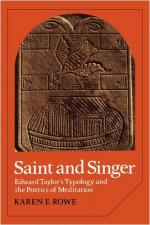|
This section contains 1,192 words (approx. 4 pages at 300 words per page) |

|
SOURCE: Scheick, William J. “Taylor's ‘Meditation 1.30.’” Explicator 58, no. 1 (fall 1999): 8-10.
In the following essay, Scheick discusses Taylor's use of certain elements of Roman Catholicism in his “Meditation 1.30.”
Because Edward Taylor was a theologically conservative minister, the seemingly un-Puritan features of his poetic meditations have often vexed critics. Few, however, have explored those features in depth. Read closely, “Meditation 1.30” reveals even more surprises than are customarily recognized in Taylor's verse. This critically neglected poem, a verse prayer of petition staged as a dramatic monologue spoken by a medieval crusader, controversially adapts Roman Catholic history and liturgy.
Throughout the poem the human body is likened to a ship, a metaphor also prominent in Taylor's “Meditation 1.28.” “Meditation 1.30” opens with an image of the human body as “The finest vessell” ever “fram'de” now “ruinde” by its creator's “Enemy” (2, 6). As a result of humanity's “Fall” (7)—also a nautical term referring to a vessel's...
|
This section contains 1,192 words (approx. 4 pages at 300 words per page) |

|


